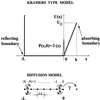Ion channel gating: a first-passage time analysis of the Kramers type
- PMID: 11891285
- PMCID: PMC122561
- DOI: 10.1073/pnas.052015699
Ion channel gating: a first-passage time analysis of the Kramers type
Abstract
The opening rate of voltage-gated potassium ion channels exhibits a characteristic knee-like turnover where the common exponential voltage dependence changes suddenly into a linear one. An explanation of this puzzling crossover is put forward in terms of a stochastic first passage time analysis. The theory predicts that the exponential voltage dependence correlates with the exponential distribution of closed residence times. This feature occurs at large negative voltages when the channel is predominantly closed. In contrast, the linear part of voltage dependence emerges together with a nonexponential distribution of closed dwelling times with increasing voltage, yielding a large opening rate. Depending on the parameter set, the closed-time distribution displays a power law behavior that extends over several decades.
Figures




Similar articles
-
Activation properties of Kv4.3 channels: time, voltage and [K+]o dependence.J Physiol. 2004 Jun 15;557(Pt 3):705-17. doi: 10.1113/jphysiol.2003.058578. Epub 2004 Mar 5. J Physiol. 2004. PMID: 15004209 Free PMC article.
-
Free energy dissipation of the spontaneous gating of a single voltage-gated potassium channel.Chaos. 2018 Feb;28(2):023103. doi: 10.1063/1.5022980. Chaos. 2018. PMID: 29495676
-
Coupling between charge movement and pore opening in voltage dependent potassium channels.Medicina (B Aires). 1995;55(5 Pt 2):591-9. Medicina (B Aires). 1995. PMID: 8842189
-
How does voltage open an ion channel?Annu Rev Cell Dev Biol. 2006;22:23-52. doi: 10.1146/annurev.cellbio.21.020404.145837. Annu Rev Cell Dev Biol. 2006. PMID: 16704338 Review.
-
Structure, function, and modification of the voltage sensor in voltage-gated ion channels.Cell Biochem Biophys. 2008;52(3):149-74. doi: 10.1007/s12013-008-9032-5. Epub 2008 Nov 7. Cell Biochem Biophys. 2008. PMID: 18989792 Review.
Cited by
-
Beta-Barrel Channel Response to High Electric Fields: Functional Gating or Reversible Denaturation?Int J Mol Sci. 2023 Nov 23;24(23):16655. doi: 10.3390/ijms242316655. Int J Mol Sci. 2023. PMID: 38068977 Free PMC article.
-
Slowing the translocation of double-stranded DNA using a nanopore smaller than the double helix.Nanotechnology. 2010 Oct 1;21(39):395501. doi: 10.1088/0957-4484/21/39/395501. Epub 2010 Sep 1. Nanotechnology. 2010. PMID: 20808032 Free PMC article.
-
A phase transition in the first passage of a Brownian process through a fluctuating boundary with implications for neural coding.Proc Natl Acad Sci U S A. 2013 Apr 16;110(16):E1438-43. doi: 10.1073/pnas.1212479110. Epub 2013 Mar 27. Proc Natl Acad Sci U S A. 2013. PMID: 23536302 Free PMC article.
-
Principles of conduction and hydrophobic gating in K+ channels.Proc Natl Acad Sci U S A. 2010 Mar 30;107(13):5833-8. doi: 10.1073/pnas.0911691107. Epub 2010 Mar 15. Proc Natl Acad Sci U S A. 2010. PMID: 20231479 Free PMC article.
-
History-dependent multiple-time-scale dynamics in a single-neuron model.J Neurosci. 2005 Jul 13;25(28):6479-89. doi: 10.1523/JNEUROSCI.0763-05.2005. J Neurosci. 2005. PMID: 16014709 Free PMC article.
References
-
- Hille B. Ionic Channels of Excitable Membranes. 3rd Ed. Sunderland, MA: Sinauer; 2001.
-
- Sakmann B, Neher E, editors. Single-Channel Recording. 2nd Ed. New York: Plenum; 1995.
-
- Hänggi P, Talkner P, Borkovec M. Rev Mod Phys. 1990;62:251–342.
-
- Mainen Z F, Joerges J, Huguenard J R, Sejnowski T J. Neuron. 1995;15:1425–1439. - PubMed
Publication types
MeSH terms
Substances
LinkOut - more resources
Full Text Sources
Other Literature Sources

